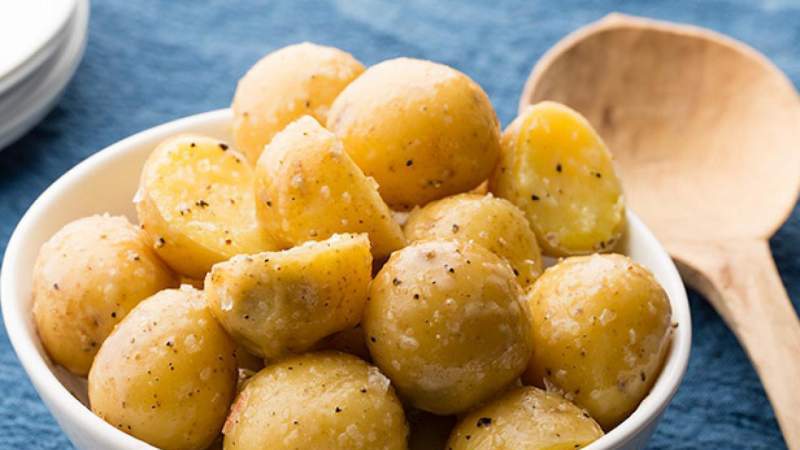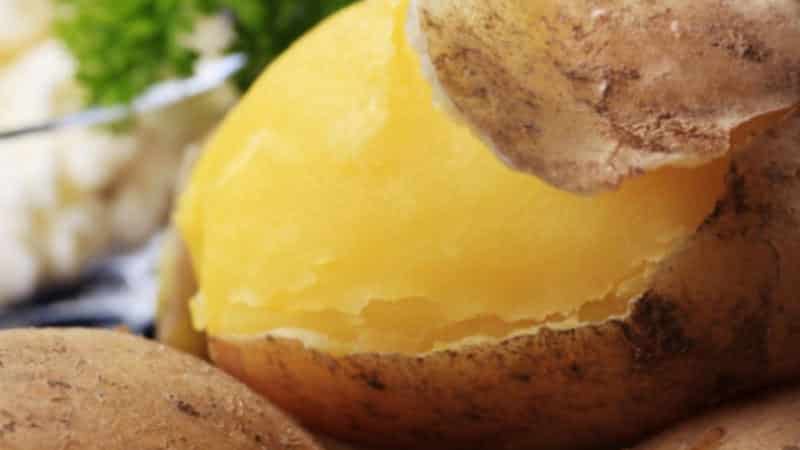What to do if potato tubers become crumbly during cooking, and why this happens
Potatoes are among the most popular foods around the world. It is consumed both as an independent dish and as an additional ingredient. Some varieties cooking become crumbly, but this is not always the quality desired by the consumer.
Let's figure out which potatoes crumble when cooked, what determines the friability of potatoes, and how to choose the right variety to create your culinary masterpiece.
Starch and its content in potatoes
Why do potatoes become crumbly when cooked? This directly depends on the amount contained starch. The average figure is 15-16% and varies both up and down depending on varieties. The less starch, the denser the finished potatoes will be. There is little of it in young tubers of any variety, but as they grow older it accumulates. Mature tubers are boiled until cracked and are suitable for puree.
 Some housewives think that the reason for potatoes being soggy is the presence of a large amount of pesticides obtained during the cultivation process. However, this is fundamentally wrong. The presence of pesticides does not in any way affect friability during cooking.
Some housewives think that the reason for potatoes being soggy is the presence of a large amount of pesticides obtained during the cultivation process. However, this is fundamentally wrong. The presence of pesticides does not in any way affect friability during cooking.
Others believe that white potatoes are starchier, and this is partly true for varieties bred in neighboring countries or Russia. Exceptions are rare.
Reference! For the salad, boil the red-skinned tubers.In 7 cases out of 10, the choice will be correct.
Potatoes with yellow flesh were once considered fodder, but later scientists discovered the presence of carotene (vitamin A) and other beneficial substances in them. It holds its shape perfectly, practically does not crumble and is suitable for frying. There are few calories in yellow tubers, which makes them suitable for dietary nutrition.
What are crumbly potatoes good for?

Boiled potatoes are delicious boiled with butter. Knowing what dish it is purchased for, you can choose the appropriate variety.
Tubers with tough skin and yellow flesh contain less starch and are suitable for stir-frying and salads. But for mashed potatoes or thick soup, potatoes with tough skin and pale flesh are the ideal choice. It crumbles perfectly and has high nutritional value.
What is it not suitable for?
If you want to fry potatoes, don't choose starchy tubers. This will not have a golden brown crust, and the slices will fall apart into mush - dinner and your mood will be ruined. When purchasing, pay attention to the skin and pulp on the cut.
Potatoes with tender, flaky skin and a pale yellow body contain less starch and can withstand any type of cooking. Red potatoes are good for frying, but yellow varieties are also an excellent choice if the skin is thick and the flesh is bright.
Why do potato tubers become crumbly when cooked for a long time?
Tubers become overcooked not only due to their high starch content, but also due to prolonged heat treatment. The splitting reaction of crumbly varieties occurs at a temperature 12°C lower than that of waxy cultures.
Intercellular connections are destroyed even with slight heat treatment, and the tuber becomes soft and granular.
Which potatoes are crumbly when cooked?
The more starch, the faster the potatoes crumble. It all depends on the correctness of your choice. Cooking at high temperatures or frequent stirring leads to boiling of any varieties.
Attention! The tubers for heat treatment must be identical, otherwise half will fall apart and the other will remain damp. It is better to cut them into equal large pieces.
Is it good or bad

If you want to make the most delicate puree, choose the crumbly variety. The grainy structure of the finished dish will perfectly absorb milk, sour cream or butter. These ingredients will imbue the puree with a unique aroma and make it especially tasty.
For frying, choose potatoes that contain more carotene. It contains fewer nutrients and will not affect your figure. In the West, waxy varieties are more often eaten, because they are ideal for salads. And crumbly tubers are absolutely unsuitable for frying.
What does friability depend on?
Friability is affected by the percentage of starch to protein in a particular potato variety. It will hold its shape well during cooking if there is 8 times less protein, but a proportion of 1:16 indicates that it will quickly fall apart. The main role is given to the strength of molecular compounds.
The chemical composition of tubers and their properties depend on:
- From the characteristics of the growing season. The earliest varieties do not have time to accumulate starch and other dry substances.
- From agrotechnical conditions. A large amount of nitrogenous fertilizers makes potatoes watery.
- From the timing of the harvest. Young potatoes are always a little unripe, and there is little starch in them.
- From the terms and conditions of storage.Temperatures from 0 to +1°C break down starch into sugars, which gives it a sweetish taste. If the tubers have sprouted, there will be few nutrients left - they are used for the formation of sprouts.
- From the cooking technique. Boiling the tubers in cold water and pre-soaking them removes excess starch, making them denser.
Both white and red varieties have increased friability. Their technological differences are minor, but It used to be that pink imported potatoes were denser and good for frying. It was in its category (A-B), but today everything depends on the characteristics of the variety, and not the color of the skin.
How to choose the right potatoes for boiling

When choosing potatoes for cooking, proceed from your own taste preferences and the dish you are preparing. Sometimes it is good in the form of neat slices with sauce, but for puree it is better to choose starchy tubers.
For some thick soups, the potatoes are boiled whole and mashed with a fork, but, for example, the boiled liquid will make chicken broth unappetizing.
Many domestic chefs advise choosing tubers with a starch content of no more than 15%:
- Early Zhukovsky. It goes on the market in mid-August. The tubers are large or medium-sized, reddish in color. The pulp is slightly watery, white and dense. Starch content - 10-12%.
- Meteor. Very early variety. The peel, like the pulp, is light yellow. The tubers are moderately boiled, become soft and watery, but retain their shape during cooking. Starch content - 12-14.9%.
- Gala. Medium early variety. The flesh and skin are yellow. During heat treatment, it retains its structure. Starch content - 11-13%.
In supermarkets you can find imported bags of prepackaged potatoes.. They have markings indicating which dish is best to use them for:
- A - potatoes for salad;
- B - grade for chips, slightly boiled;
- C - grade for French fries;
- D is a starchy variety for purees.
Conclusion
Potatoes contain a lot of proteins, vitamins and microelements. Any dish is ideally complemented by herbs and vegetables. Crispy potatoes have a more delicate taste and are good for boiling or baking. But each person has his own taste preferences, which means that when choosing, you should be guided by them.
Not everyone likes foreign potatoes and housewives taste like bars of soap. Ignore the advertising, eat the potatoes you really like.